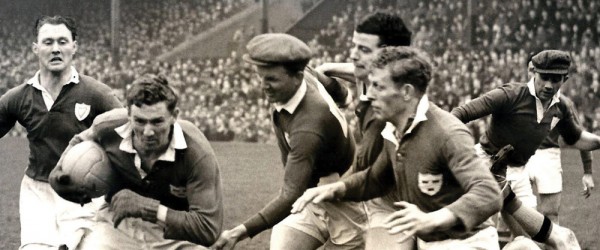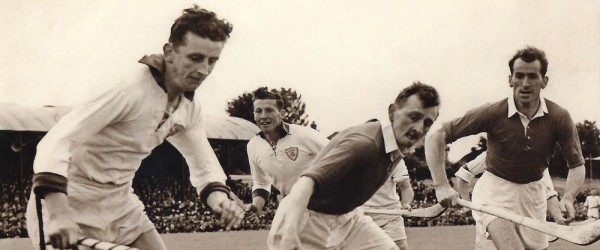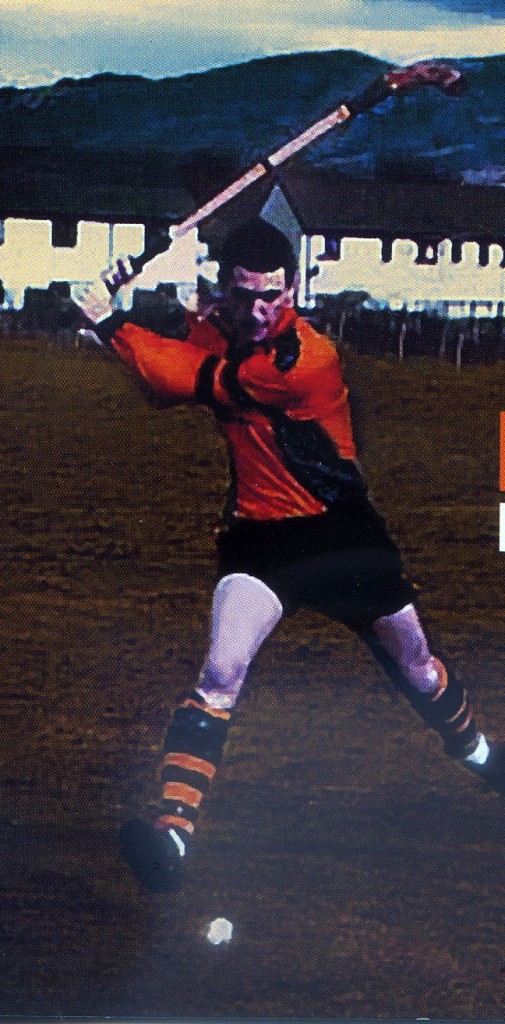The
Shinty StickHurleys belonging to former famous players abound in Lár na Páirce, but there among them are at least two shinty sticks, which is an added bonus for the visitor. Shinty is a team game played in Scotland with sticks and a ball. It is now played mainly in the Highlands, and amongst Highland migrants to the big cities. Shinty is nowadays played by about forty clubs. In Scots Gaelic the game is called camanachd or iomain and the sticks are known as camans, which has a very close similarity to the Irish language terms for the game of hurling. Shinty was organised and codified in the late 19th century and the oldest trophy still contested is the Camanachd Association Challange Cup, which Kingussie was the first to win in 1896.
While comparisons are often made with hockey, the two games have several important differences. In shinty, a player is allowed to play the ball in the air and is allowed to use both sides of the caman, which is wooden and slanted on both sides. The stick may also be used to block and to tackle. Players may also tackle using the body as long as it is shoulder-to-shoulder. Corners are taken like soccer.
An interesting reference to the game of shinty in Ireland appears on a fifteenth century Galloglass’s grave-slab uncovered in the graveyard of the ruined church at Clonca, on the Inishowen peninsula in the far north of Donegal. Carving on the stone clearly depicts a sword, shinty-stick and ball.
The objective of the game of shinty is to play a small ball into a goal, erected at the ends of a 140 to 170-yard-long by 70 to 80-yard-wide pitch. The game is traditionally played on grass. The ball is a hard solid sphere of around half the diameter of a tennis ball, consisting of a cork core covered by two pieces of leather stitched together. The seam is raised, very similar to that of the hurling sliotar. The caman is a stick of about 1.1 metres long with two slanted faces and the head, which is wedge shaped. The caman is traditionally made of ash but now more commonly hickory. A player may only stop the ball with the stick, the chest, two feet together or one foot on the ground. Only the goalkeeper may use his hands, but only with an open palm since he is not allowed to catch it. The winner of a game is the team that scores the most goals. Teams consist of twelve players (men) or ten players (women), including a goalkeeper. A match is played over two halves of 45 minutes. Shinty was traditionally played through the winter, based around the tradition of the “Iomain Challainn”, where New Year was marked by a game between neighbouring parishes.
As both Hurling and Shinty lack international games and are quite similar, an annual hybrid game is played. The first ever shinty/hurling ‘international’ was played in Glasgow in 1897. That this event ever took place was due in no small part top two key people, John Murdoch in Scotland and Michael Cusack in Ireland, both of whom were involved with newspapers, The Highlander in Scotland and The Celtic Times in Ireland. That year Cusack donated the Celtic Times Challenge Cup for an annual hurling /shinty game which is understood to have taken place intermittently in Dublin at least up to 1919. In more recent times Scotland and Ireland have played on a home and away basis using composite rules.
This final verse of the Runrig song-Clash of the Ash shows the similarity of ethos between Hurling and Shinty-
This story started long ago,
With heroes forged and legends told,
And for every fighting Highland man,
Stand by your brother, die for the clan.
Well when the whistle blows and the battle’s done,
These shinty boys shine like the sun,
We don’t play for fame, we don’t play for cash,
We just play for the glory and the clash of the ash.






